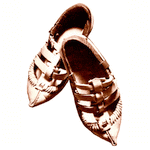Šilovačko Oro – Serbia [Dick Oakes*, John Filcich*]
This is an oldie, now revived. Dick Oakes taught it to the CSU Wednesday folk dancing. The only thing I dislike about the dance is that the phrasing is 10 bars, so it gets off from the music, so I have to think more about the dance phrasing and can’t just let the music “tell me what to do.”
Video Variation Note: In the first phrase (4 bars) the Dunav dancers keep the downbeat with the R whereas the Davis, CA; Haifa; and Dick’s notes start each bar (downbeat) with the L. It all works out with the presence or absence of a pause in bar 5. There was some controversy at TNFD when I tried to teach it the L on downbeat way, but most of the seasoned dancers did it that way anyhow when I skipped the teaching and just put the music on.
From Dick’s Notes:
Dick Oakes learned Šilovačko oro in 1971 from members of the AMAN Folk Ensemble (aka, AMAN International Music and Dance Company) of Los Angeles, California, who had learned it from “Narodne Igre,” Danica and Ljubica Janković (published in their book Narodne Igre). John Filcich presented the dance at the 1971 Idyllwild Folk Dance Workshop.
This “čačak” type dance, also known simply as “Šilovačko,” is from the village of Šilovo, a few kilometers northeast of the town of Gnjilane (Gjilan) in the municipality of Gnjilane in Kosovo. Although the dance is from Kosovo, it is considered Serbian. Gnjilane is in an area of Serbia that became Kosovo-Metohija. Gnjilane as a settlement was formed around 1750, and as an urban center in 1772 and, as a town, developed in addition to the extinction of Artana, which in the Middle Ages was one of the cities and the largest commercial, economic, and mining centers in the Balkans. Originally, Šilovačko was a women’s dance, but more recently, both men and women have performed the dance.
https://socalfolkdance.org/dances/S/Silovacko_Oro_A_Serbian.pdf

